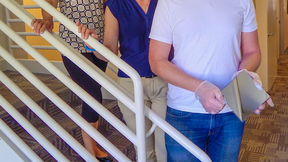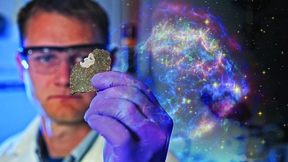Back
Physical and Life Sciences
Lawrence Livermore renews pact with Georgetown University to expand research and education in science and policy
Director Bill Goldstein and GeorgetownPresident John DeGioia on Friday renewed their institutional commitment by signing a memorandum of understanding for an additional five years to expand the collaborative work in the areas of cyber security, biosecurity, nonproliferation and global climate, energy and environmental sciences.This renewal represents a significant…
New energy record set for multilayer-coated mirrors
Multilayer-coated mirrors, if used as focusing optics in the soft gamma-ray photon energy range, can enable and advance a range of scientific and technological applications that would benefit from the large improvements in sensitivity and resolution that true imaging provides. In a paper published in a recent online edition of Optics Express, LLNL postdoc Nicolai Brejnholt…
Simulating the south Napa earthquake
Lawrence Livermore seismologist Artie Rodgers is tapping into LLNL's supercomputers to simulate the detailed ground motion of last month's magnitude 6.0 south Napa earthquake. The Napa tremor is the largest to hit the Bay Area since the magnitude 6.9 Loma Prieta event in 1989. Using descriptions of the earthquake source from Professor Douglas Dreger of the University of…
Giant Steps for Adaptive Optics
Livermore teams are now working on an adaptive optics system to transport x-ray beams in a new generation of high-energy research facilities.
Livermore team awarded for hydrogen production research
Three Lawrence Livermore researchers have received the Department of Energy's 2014 Hydrogen Production R&D Award for developing a system that uses sunlight to split water molecules, producing hydrogen. Shared with collaborators from the National Renewable Energy Laboratory (NREL)and the University of Nevada, Las Vegas (UNLV), the award recognizes the team for its work…
Tracing tainted food back to its source
Imagine identifying the source of an outbreak from contaminated foods within hours instead of weeks. That's what several University of Oklahoma (OU) summer interns believe an innovative Lawrence Livermore National Laboratory (LLNL) technology is capable of doing.OU students Alyssa Boutelle, Michael Petri and Lauren Gilbert evaluated a new market opportunity for an…
Calculating conditions at the birth of the universe
Using a calculation originally proposed seven years ago to be performed on a petaflop computer, Lawrence Livermore researchers computed conditions that simulate the birth of the universe.When the universe was less than one microsecond old and more than one trillion degrees, it transformed from a plasma of quarks and gluons into bound states of quarks - also known as…
Construction of Large Synoptic Survey Telescope to begin
The National Science Foundation (NSF) has agreed to support the Association of Universities for Research in Astronomy (AURA) to manage the construction of the Large Synoptic Survey Telescope (LSST). This marks the official federal start of the LSST project, the top-ranked major ground-based facility recommended by the National Research Council's Astronomy and Astrophysics…
New project is the ACME of addressing climate change
High performance computing (HPC) will be used to develop and apply the most complete climate and Earth system model to address the most challenging and demanding climate change issues. Eight national laboratories, including Lawrence Livermore, are combining forces with the National Center for Atmospheric Research, four academic institutions and one private-sector company…
It's nanotubular: New material could be used for energy storage and conversion
Lawrence Livermore researchers have made a material that is 10 times stronger and stiffer than traditional aerogels of the same density.This ultralow-density, ultrahigh surface area bulk material with an interconnected nanotubular makeup could be used in catalysis, energy storage and conversion, thermal insulation, shock energy absorption and high energy density physics…
Scientists burst onto influential list for combustion research
Lawrence Livermore scientists Charles Westbrook and William Pitzhave been named to Thomson Reuters list of "The World's Most Influential Scientific Minds."Westbrook and Pitz are part of the 3,000 researchers who were identified by analyzing citation data over the last 11 years to recognize those who published the highest-impact work (2002-2012 and 2012-2013). The two were…
Getting more life out of lithium-ion batteries
Your cell phone may stay charged longer due to advances in modeling lithium-ion battery storage capacity.New research indicates that lithium-ion batteries could benefit from a theoretical model created at Lawrence Livermore National Laboratory and Rice University that predicts how carbon components will perform as electrodes.The growing demand for energy storage emphasizes…
Peering into giant planets from in and out of this world
Lawrence Livermore scientists for the first time have experimentally re-created the conditions that exist deep inside giant planets, such as Jupiter, Uranus and many of the planets recently discovered outside our solar system.Researchers can now re-create and accurately measure material properties that control how these planets evolve over time, information essential for…
Lab expertise tapped to understand how the brain retrieves memories
Livermore scientists are developing electrode array technology for monitoring brain activity as part of a collaborative research project with UC San Francisco to better understand how the neural circuitry of the brain works during memory retrieval.The long term goal of the research is a deeper understanding of the brain's memory processes so physicians can better treat…
Lawrence Livermore technology could screen for emerging viral diseases
A microbe detection array technology developed by Lawrence Livermore National Laboratory(LLNL) scientists could provide a new rapid method for public health authorities to conduct surveillance for emerging viral diseases.This possible use of the Lawrence Livermore Microbial Detection Array (LLMDA) was studied by an international team of researchers from eight nations in a…
International research team shoots molecular movies of photosynthesis
An international team of scientists, including researchers from Lawrence Livermore National Laboratory (LLNL), has caught a central step of photosynthesis in action for the first time.The team, led by Petra Fromme of Arizona State University, used the world's most powerful X-ray flashlight at the SLAC National Accelerator Laboratory to record still frames of a molecular…
Lawrence Livermore scientists measure rock in a hard place
Measuring the extreme pressures and temperatures of hydrothermal systems in the Earth's crust is no easy feat.However, Lawrence Livermore National Laboratory scientists have made a new tool that allows them to probe pressures up to 20 kbar (20,000 Earth atmospheres of pressure).The equation of state of the Earth's crust where water-rock interactions occur is believed to be…
Evidence of a Turbulent Beginning
Research from a Livermore-led team suggests our solar system’s birth was chaotic and included input from a nearby supernova explosion early in its evolution.
LLNL researchers define boundaries for petawatt laser absorption
The absorption of petawatt (10 15 watts) laser light by solid matter is a crucial problem that has been the subject of theoretical and experimental study for more than two decades. In a newly-published paper, Lawrence Livermore scientists have defined, for the first time, a set of theoretical boundaries for the absorption of petawatt laser light. The scientists present…
Heading toward the hydrogen highway
Lawrence Livermore scientists are working on a project that will use particles considerably smaller than the size of a human hair to improve the storage capacity of hydrogen-powered vehicles.Using $1.2 million from the Department of Energy's Office of Energy Efficiency and Renewable Energy (EERE) over three years, LLNL scientist Brandon Wood said that through theory and…
























